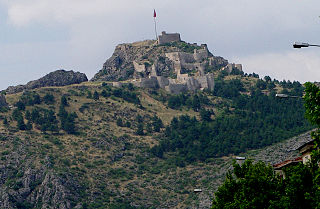
Tiryns is a Mycenaean archaeological site in Argolis in the Peloponnese, and the location from which the mythical hero Heracles was said to have performed his Twelve Labours. It lies 20 km (12 mi) south of Mycenae.

The Arg-e Bam, located in the city of Bam, Kerman Province of southeastern Iran, is the largest adobe building in the world. The entire building was a large fortress containing the citadel, but because the citadel dominates the ruins, the entire fortress is now named Bam Citadel.

Rize is a coastal city in the eastern part of the Black Sea Region of Turkey. It is the seat of Rize Province and Rize District. Its population is 119,828 (2021). Rize is a typical Turkish provincial capital with little in the way of nightlife or entertainment. Since the border with Georgia was opened in the early 1990s, the Black Sea coast road has been widened and the town is much wealthier than it used to be. Current Turkish President Recep Tayyip Erdoğan's family has its roots in Rize and the local university is named after him. The city is linked by road with Trabzon, Hopa (55 miles [88 km] east on the Georgian border, and Erzurum. Rize–Artvin Airport started operating in 2022.

Zilkale is a medieval castle located in the Fırtına Valley within the Pontic Mountains, and is one of the most important historical structures in the Çamlıhemşin district of Rize Province, within the Black Sea Region of Turkey.

Alanya Castle is a medieval castle in the southern Turkish city of Alanya.

Citadel of the Hồ Dynasty is a 15th century stone fortress in Thanh Hóa, Vietnam. It served as the western capital of the Hồ dynasty (1398–1407) while also being an important political, economic, and cultural centre in the 16th to the 18th century. It is located in modern Tây Giai commune, Vĩnh Lộc District, in Thanh Hóa Province, in Vietnam's North Central Coast region.

Prusias ad Hypium was a city in ancient Bithynia, and afterwards in the late Roman province of Honorias. In the 4th century it became a bishopric that was a suffragan of Claudiopolis in Honoriade. Before its conquest by King Prusias I of Bithynia, it was named Cierus or Kieros and belonged to the Heraclea Pontica. Photius writes that it was called Kieros, after the river which flows by it.

The Walls of Trabzon are a series of defensive walls surrounding the old town of the city of Trabzon, northeastern Turkey. The fortifications are sometimes called the Trabzon Castle. However, they did not function as a castle, rather as city walls. Constructed on foundations dating back to the Roman era with cut stones from former structures at site, the walls stretch from the hill on the backside of the old town to the Black Sea shore. The walls further divided the city into three parts; the Upper Town or "fortress", the Middle Town and the Lower Town. The upper and middle towns are flanked by steep ravines cut by the Zagnos (Iskeleboz) and Tabakhane (Kuzgun) streams to the west and east respectively, while the lower town extends to the west of Zagnos.

Greifenstein Castle is a ruined castle in the municipality of Filisur of the Canton of Graubünden in Switzerland. It is included on the register of the Swiss Inventory of Cultural Property of National and Regional Significance.

The Castle of Kars is a former fortification located in Kars, Turkey. It is also known under the name İç Kale.

Samsun Castle was a castle in Samsun, Turkey. Built on the seaside in 1092, it was demolished between 1909 and 1918.

The Öküz Mehmed Pasha Caravanserai is a caravanserai located in Kuşadası, Aydın Province, western Turkey, built by Ottoman statesman and military commander "Öküz" Mehmed Pasha. After its renovation, the building is used as a hotel today.

The Ioannina Castle is the fortified old town of the city of Ioannina in northwestern Greece. The present fortification dates largely to the reconstruction under Ali Pasha in the late Ottoman period, but incorporates also pre-existing Byzantine elements.

Hebilli Castle is a ruined castle in Mersin Province, Turkey.

Güvercinada is an island in western Turkey connected to mainland Kuşadası of Aydın Province via a relatively narrow, man-made causeway which is 350 m (1,150 ft) in length.

The Fortifications of Diyarbakır are a set of fortifications enclosing the historical district of Sur in Diyarbakır, Turkey. They consist of an inner fortress, the citadel, and an outer ring of city walls.

The Castle of Mirandela is a medieval castle in the civil parish of Mirandela, municipality of the same name, in the Portuguese district of Bragança.

Amasya Castle, a.k.a.Harşene Castle, is a fortress located in Amasya, northern Turkey.

Tece Castle is a ruined castle in Mersin Province, southern Turkey.

Zerzevan Castle, also known as Samachi Castle, is a ruined Eastern Roman castle, a former important military base, in Diyarbakır Province, southeastern Turkey. Archaeological excavations at the site revealed the existence of underground structures, among them a temple of Mithraism, a mystery religion. The castle was used as a civilian settlement between the 1890s and the 1960s. The site is partly open to tourism.























